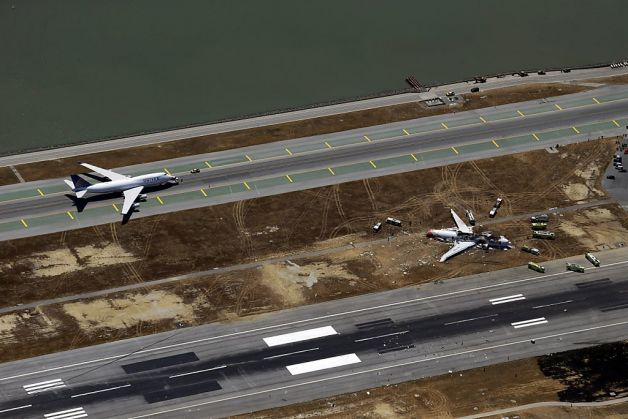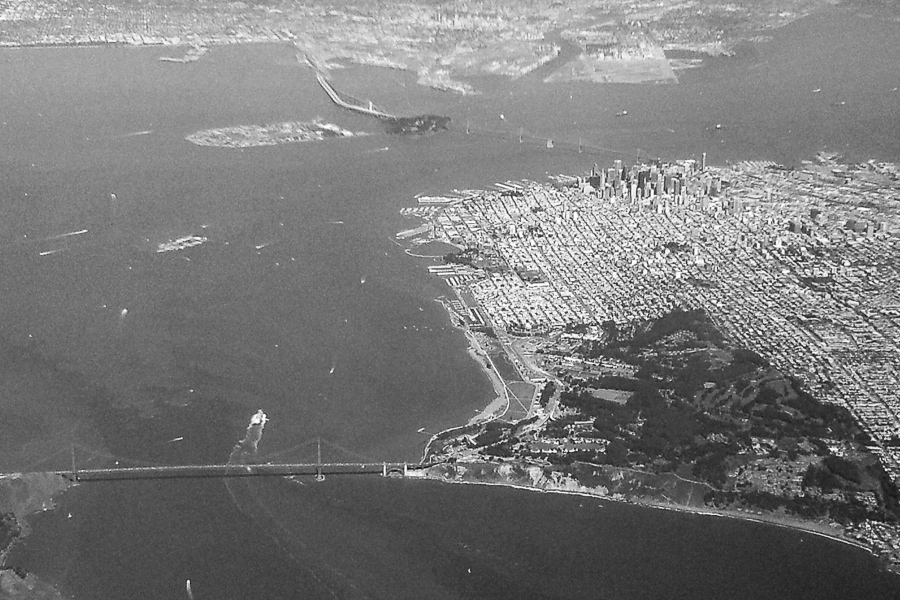...because I didn't have time to read them today:
I will now go home and read these things on the way.
It completely passed me by that last week was the 30th anniversary of one of aviation's biggest moments in "it could have been worse," when an Air Canada 767 ran out of fuel over western Ontario:
On 23 July 1983, flight 143 was cruising at 41,000 ft., over Red Lake, Ontario. The aircraft's cockpit warning system sounded, indicating a fuel pressure problem on the aircraft's left side. Assuming a fuel pump had failed,[3] the pilots turned it off,[3] since gravity should feed fuel to the aircraft's two engines. The aircraft's fuel gauges were inoperative because of an electronic fault which was indicated on the instrument panel and airplane logs (the pilots believed flight to be legal with this malfunction). The flight management computer indicated that there was still sufficient fuel for the flight; but the initial fuel load had been entered as pounds instead of kilograms. A few moments later, a second fuel pressure alarm sounded for the right engine, prompting the pilots to divert to Winnipeg. Within seconds, the left engine failed and they began preparing for a single-engine landing.
As they communicated their intentions to controllers in Winnipeg and tried to restart the left engine, the cockpit warning system sounded again with the "all engines out" sound, a long "bong" that no one in the cockpit could recall having heard before and that was not covered in flight simulator training.[3] Flying with all engines out was something that was never expected to occur and had therefore never been covered in training.[4] Seconds later, with the right-side engine also stopped, the 767 lost all power, and most of the instrument panels in the cockpit went blank.
What happened next...is worth reading about.
Thanks to Jim Fallows for reminding me about this anniversary.
Three weeks ago, I visited San Francisco. Two days after I flew out of SFO, there was the first fatal air-transport accident in the U.S. in 12 years.
Sunday, I flew out of LaGuardia, and yesterday a Southwest Airlines plane suffered a nose-gear collapse on landing:
The front landing gear of a Boeing 737 operated by Southwest Airlines collapsed upon landing at La Guardia Airport on Monday evening, thrusting the plane’s nose into the tarmac and sending out a stream of sparks as the plane skidded to a stop, officials and witnesses said.
At least [8] people were injured, according to the Port Authority of New York and New Jersey, which operates the airport; six of those were taken to Elmhurst Hospital Center. The extent of their injuries was not immediately known, though it appeared that none were serious.
The airport was closed for about 80 minutes, and one of its two main runways reopened at 7:06 p.m.
All the injuries were minor.
Good thing I'm not scheduled to fly anywhere for five weeks.
Two weeks ago, I described my experience zipping through SFO's security lines. Because I have elite status on American Airlines and because I'm in the CBP's Global Entry program, I qualified automatically for TSA PreCheck.
Yesterday, TSA administrator John Pistole announced that now, any U.S. citizen traveler can apply:
Until now, travelers could only apply to use PreCheck if they were members of certain airline frequent flier programs or were enrolled in "trusted traveler" programs with the U.S. Customs and Border Patrol.
The expansion is part of the TSA's efforts to focus more attention on high-risk travelers and cut back on the screening time spent on frequent travelers.
Travelers who pay the $85 must submit to fingerprinting and a background check. Applicants who are cleared by the TSA are enrolled to use the PreCheck lines for five years.
I'd say it's worth $85 to get through security lines at speeds not seen since the last century.
First, a Boeing 787 caught fire at Heathrow this afternoon; fortunately, no one was aboard:
Video footage showed the plane surrounded by foam used to quell the flames. The airport said in a statement that it was an on-board internal fire, but didn’t offer more details. It said the plane was empty, parked in a remote area and there were no reported injuries. All flights in and out were temporarily suspended Friday afternoon -- a standard procedure if fire crews are called out.
Ethiopian Airlines said smoke was detected coming from the aircraft after it had been parked at Heathrow for more than eight hours.
You can bet that Chicago-based Boeing will watch this story very, very carefully. Their shares dropped 7% on the news, for one thing.
In other unfortunate aviation news, the San Francisco Police have confirmed that one of the two victims of the Asiana 214 crash got run over by a fire truck, but they don't know yet whether she was alive when this happened:
Medical examiners will not release autopsy results for “at least two or three weeks,” San Mateo County Coroner Robert Foucrault told NBC Bay Area on Sunday. Coroner’s officials are working to determine how 16-year-old Ye Mengtuan died.
Police officials confirmed that the girl was hit by the truck in the chaos that followed the deadly crash, which also killed her classmate and travel companion, identified by the airline as 16-year-old Wang Linjia.
The girl was blanketed in white foam emergency crews sprayed to douse the flames billowing out of the Boeing 777, police said. She was discovered in the tire track of the fire truck, police spokesman Albie Esparza told NBC News.
Not a good week for aviation.
Yesterday, an Asiana 777 crashed on approach to San Francisco airport:

Two people were killed and 49 seriously hurt when Flight 214 crashed at 11:27 a.m. But the rest of the 307 passengers and crew members escaped either unscathed or with lesser injuries, Doug Yakel, an SFO spokesman, said at an evening news conference.
The plane came to rest on the side of Runway 28L, one of four runways at SFO, said Lynn Lunsford, a spokeswoman with the Federal Aviation Administration. The jetliner appeared to hit short of the runway and then slowly turn as it careened across the ground - losing its tail and leaving a trail of debris.
(Photo: AP/Marcio Jose Sanchez)
Initial reports suggest the plane had a higher-than-normal angle of attack on an otherwise normal approach, and its tail struck the seawall at the end of 28L—the runway my Alaska 737 landed on last Saturday. It also seems from the reports that the pilots attempted a go-around immediately before the tail strike, which would explain the higher angle of attack and the reports of the plane "bouncing up" and "putting on the gas" from passengers.
I'll be following this story closely. This is the first-ever fatal accident for the Boeing 777, and the first fatal heavy airplane accident since 12 November 2001.
From getting out of my cab at San Francisco Airport this morning until I finally got through the security line took seven whole minutes, including checking a bag.
Yes. Seven minutes.
I don't understand why more people aren't signing up for the TSA PreCheck program. If you're in the program, you can zip through airport security without removing your shoes, emptying your bag, or waiting behind people who have never seen a magnetometer before.
Eligible travelers
...include U.S. citizens of frequent flier programs who have been invited by a participating airline. Additionally, U.S. citizens who are members of a CBP Trusted Traveler program, including Global Entry, SENTRI, and NEXUS and Canadian citizens who are members of NEXUS that are issued a Known Traveler Number qualify to participate. Passengers 12 and younger are allowed through TSA Pre✓™ lanes with eligible passengers.
TSA Pre✓™ is currently available for eligible passengers traveling on Alaska Airlines, American Airlines, Delta Air Lines, United Airlines, US Airways and Virgin America.
Seriously. Seven minutes from the curb to the gate area.
Of course, with the BART strike (possibly ending later today), it took me over an hour to get here, but that's beside the point.
It turns out, I'm working a lot more than I anticipated this week, in addition to being on, you know, vacation, so not much blogging for the next day or two.
Meanwhile, this is what I got to see on our descent to SFO two days ago:

The quality could be better, but that's because I snapped it with my tablet about 15 seconds before the flight attendants told me to turn it off. But it shows pretty well why I always sit in the window seat.
It turns out, all of O'Hare has free WiFi these days, so I can do work right at the gate when my plane's delayed by several short intervals. (A long delay would have seen me in the club, what what!)
Tonight I'll be at Safeco Field watching the Cubs probably lose to the Mariners and taking in my 25th park. Right now, I'm at H11A waiting for them to clean the plane.
Pretty normal travel day, except for getting out of the Loop.
As I mentioned yesterday, United Airlines will start requiring their elite fliers to meet spending thresholds to keep elite status. Here's the Cranky Flier's take:
If you’re actually earning 25,000 miles from flying and haven’t spent $2,500 on United, then United might not consider you to be worth trying to keep in the program. Either you’re trying to game the system through a really cheap mileage run, or you’re getting incredibly lucky with low fares since those are pretty tough to find these days. Or maybe you’re just flying a lot on partner airlines. I do think it’s odd that joint venture revenue on Lufthansa/Air Canada over the Atlantic or ANA over the Pacific doesn’t count, because United should view that to be the same as revenue on its airplanes. But my guess is that it’s simply a tracking problem. Either way, if you’re really flying that much on joint venture partners and not on United, then you should probably join the other airline frequent flier programs anyway.
On the whole, I don’t have a problem with this move. In fact, I applaud United as I did Delta for trying to tweak these programs to reward the kind of behavior United wants to encourage (spending money and flying a lot instead of just flying a lot). But unlike Delta, which is in a position of strength right now, United’s timing leaves something to be desired.
Again: what will US Airways do?